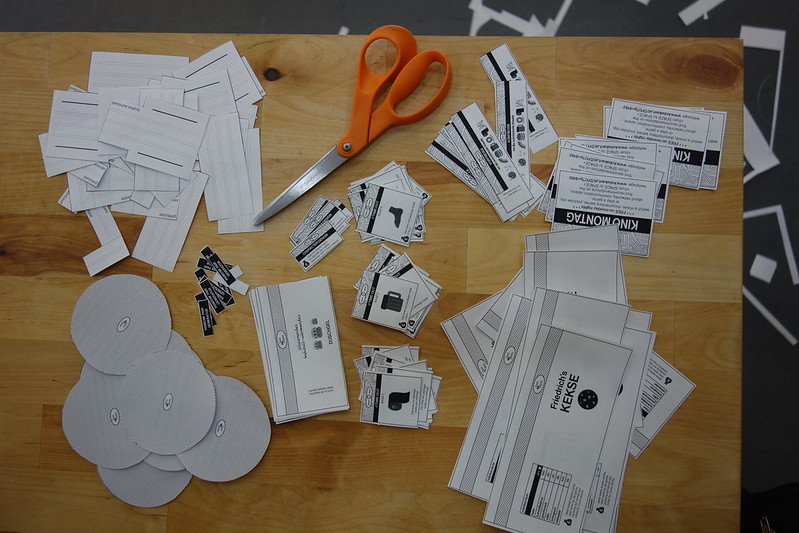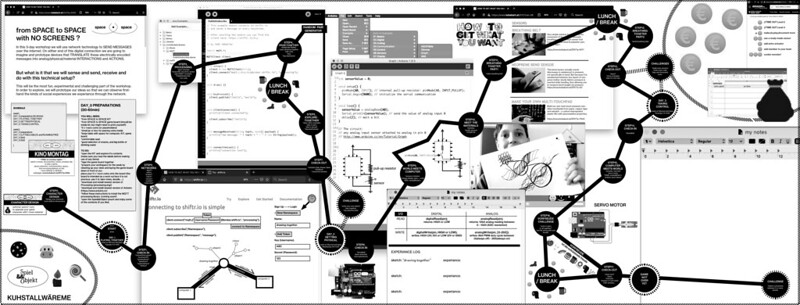Last week Friedrich summed up some of the things the (now digital?) theater scene in Germany is exploring in terms of new meeting places for performing and socializing. What Friedrich didn’t mention is that he himself has been building such a space, and over the last 2-weeks introducing our students to it in order to provide them with a tool-set/platform with which they can now build and conduct their own experimental experiences.

I won’t write much more about Friedrich’s platform (except that it is a Unity instance hosted on a server in Frankfurt, allowing us to build custom digital spaces that many many people can then enter very very easily through a browser!) in the hopes that he himself will elaborate some more on it next weekend. Plus, over the course of the next weeks we can also report on the student’s experiments on the platform (or maybe they will even do so themselves).
While Friedrich’s course (titled Vernetzte Räume / Networked Spaces) dove into the PC/smartphone (mouse+keyboard+screen/touchscreen) common setup that would allow many access. My own interest is more on how our bodies interact physically with technologies (objects.things.materials). And what possibilities arise when we are able to mediate these interactions (digitally) over the network to other humans (and non-humans). Building custom sensor/actuator controllers results in setups that are harder to make accessible to larger audiences, but this is a limitation of time&energy, not of the controller things themselves.
Since I will be teaching my workshop starting coming Tuesday, my head is quite completely occupied by it. So I thought to use this weekend reading space as a place to write down some things I’ve learned by translating my course contents that I would “normally” teach very hands on in a space full of materials and tools, into something that “makes sense of” the new circumstances – communicating remotely via audio/visual networked devices and the preparing and shipping of material KITs across town.
The Boardgame as Remote Teaching Tool?
Over the past month, I’ve been working to turn two of my courses/workshops into boardgames. Using the game board as a format for organizing and communicating the workshop contents in order to teach, or rather to lead participants through a learning experience.
This sounds so simple, but the realization that the boardgame format would work to communicate with, and lead participants through, new terrain, was an incredible one. It lead me to so many other ideas for communicating aspects of teaching, learning and making with materials by using playfulness as a means of engagement.
Preparing content to be learned/experienced in a different way, brings with it an opportunity to be(come) aware of the situatedness of the content in its new format/context. In general I’m a fan of exploring different ways of doing things as opportunities to open up knowledge spaces to people (audiences) who were not previously drawn to them. See far bellow for some more links and readings on these topics of Epistemological Pluralism and Situated Learning.
The fact that you have a boardgame in front of you, not a book, zine, online tutorial/video, situates you in a certain place where all of a sudden I can start to introduce a coin currency to be spent on certain resources (materials, knowledge, time-outs…). Limiting the number of coins you have to spend, and what items are deemed valuable enough to require purchase, is a pretend limitation, but I implement it as a reflection of the “real-world” process I (as an educator) am hoping to share with you (as a learner).

The first time I did this was for a workshop that was going to be about building dioramas and animating them in order to tell short stories.
MaterialAdventures the_boardgame (beta version)
>> https://www.plusea.at/?p=6605
instruction booklet: http://plusea.at/downloads/games/20-MaterialAdventureGame_instructions_current.pdf
The second time I did it, and am still amid the process of doing so, is for the workshop I will be teaching coming week:
from SPACE to SPACE (with NO SCREENS?) (in process)
>> https://www.kobakant.at/DIY/?p=8182
THE WORKSHOP/GAME DESIGN PROCESS
Basically, translating my former workshop topics into the boardgame format is less a process of translation and more of re-thinking them entirely. Embracing the new opportunities provided by the play/game elements to shape the flow, but also the contents.
The process of re-thinking is a constant back and forth of working through the following aspects:
*title, subtitle, introductory paragraph (laying things out in words)
These help me maintain an overview/focus of the overall learning content/experience I am aiming for.
*layout a schedule (laying things out by content and timing)
This helps define a flow. It can branch, circle back… but the linking of the contents to positions in time help arrange a kind of narrative for both me and the player.
*sketching out a path (laying things out in space)
Working physically on paper and on a 1:1 scale is incredibly important here. This process brings together the content and flow
*the graphics/aesthetics (making strong use of visual communication)
Trying out different aesthetics for the board, the visual elements (mixing and matching computer design with hand drawing, collage….)
*to-do lists (keeping track of what is possible)
Keeping track of all the things that need to get done and making sure I am able to do them in time. But also a means of deciding
The whole while, every one of these aspects has the ability to inspire or lead to a new idea. For example trying out an old game-boy icon aesthetic might lead one to discover that jump-and-run metaphors are great for explaining electron flow…….

THE GAME/PLAY
A big motivation for me to produce the physical elements was so that a majority of the workshop time could be spent playing at one’s own pace, “alone” with the materials/technology. That the connectedness with the other players could be kept rather discrete and sporadic, because I find it very consuming to have continuous audio/visual channels to others open while being amid a process of focussing-in (concentrating) on new materials/technologies, code, knowledge. At least until we build more wholesome (for lack of a better word) means of remote communication.
The BOARD and the GAME ELEMENTS are physical things that I have players print out and assemble (or I distribute as KITs to them), the COMMUNICATION between players happens over the Internet. We will use a mix of Skype for video/audio and Discord for chat/video/audio. I still need to come up with a good solution for sharing code and documentation among players……
THE BOARD
The graphical interface of the boardgame is an amazing opportunity for arranging information in a single image/instance. Not separated out over the pages of a book or navigated via endless scrolling/clicking through webpage(s).
You can perceive the entirety of the content in one go, while at the same time needing to zoom in (by focussing your attention and looking/reading) in order to take in detail. And ultimately you have to actually play the game in order to really understand all the meaning(s) embedded within.
So each time I’ve translated my workshop content into a boardgame the graphical layout of the information, and the aesthetics used to communicate with, have been extremely important elements. So much opportunity here, and such a challenge to do it well!
GAME ELEMENTS
Here a list of the game elements I have implemented so far:
*the rules and the commitment of all players to play by these rules
*start and end, and the path/route between
*choosing/creating a character to play with/through
*interactions between characters
*currency/coins as value system (introducing constraints/limitations)
*resources for purchase, gifting, collecting, exchange….
*decision moments and randomizations (chaos)
*help-cards, time-outs
*punishments and rewards
*ways to cheat (and get caught….. or feel guilty)
*competition and collaboration
*moments of suspense and disappointment

COMMUNICATION & IMAGINATION
In practice: the game(s) start with a video-call where we say hello and go over the instructions/rules together. We maybe even play some of the first steps together (if they were designed for this), but at some point the games no longer require a continuous audio/visual channel, and players retreat into their own spaces to play (play-to-make).
The board, the rules and the elements of the game now lead the player on their “material adventure”. Knowing that there are others abiding by the same rules, going through the same steps….. is what I think of (and have experienced to be) as a remote social connection. The fact that the connection “works” despite there not being any high-res digital/electronic data-transmission. The fact that we are able to IMAGINE the other and feel connected with them in the absence of an open communication channel is what draws me to this format.
Writing and sending discrete letters via snail-mail bridges time and physical distances between people, while creating continuous shared intimacy because of our ability to bridge these gaps with our imaginations. But we also need the technologies (language, symbolic notation systems, paper, pen… the postal service……. electricity, code, transistors, networks, protocols……devices ) to establish the communication channels that spark our imaginations.
GAME OVER
I think this is a good moment to end for now.
Thanks for reading!
Hannah
P.S. Interested in exploring technology and play, networked experiences, material adventures and their stories….. Come study with us in Berlin! We are NOW accepting students for next semester!
>> https://spielundobjekt.de/bewerbung/
// FURTHER READINGS
Epistemological Pluralism is a term used to refer to different ways of knowing things.
Sherry Turkle and Seymour Papert published their article “Epistemological Pluralism and the Revaluation of the Concrete” (1992) in which they studied and reflected upon different approaches that different people have in learning how to write computer code.
https://www.mit.edu/~sturkle/epistemologicalpluralism.html
“Our central thesis is that equal access to even the most basic elements of computation requires an epistemological pluralism, accepting the validity of multiple ways of knowing and thinking.”
Situated Learning and Situated Knowledges are terms that lead to much reading on a (to me) very interesting field of work and practice.
“Situated learning is a theory that explains an individual’s acquisition of professional skills and includes research on apprenticeship into how legitimate peripheral participation leads to membership in a community of practice. Situated learning “takes as its focus the relationship between learning and the social situation in which it occurs”.
–https://en.wikipedia.org/wiki/Situated_learning
Situated Knowledges: The Science Question in Feminism and the Privilege of Partial Perspective (1988) by Donna Haraway
https://philpapers.org/archive/harskt.pdf
// REFLECTIONS
Now the workshop is over and in this post I will briefly reflect on how it went went as well as provide some further reading on the topic of networked communication, art, spaces.
The gameboard worked well to lead through the week, but it functioned as an information display rather than a playable platform. The fact that it lay open on everybody’s table meant it was an ever-present shared reference, but the making of a player character and the spending of money to purchase resources remained entertaining features and did not become playful means to a learning experience.
WORLD MEETS COMPUTER
We started the week by going over networked communication between computers, servers, clients, brokers, routers…….
And then implemented a concrete instance using Processing to publish and subscribe and and MQTT broker (https://shiftr.io) with a really nice browser visualization of the system.

GETTING PHYSICAL
Next we switched from screen-based processing to physical-computing tool Arduino. But rather than switch to a wifi enabled Arduino board we kept with the simple setup and still communicated over the network via Processing.
Most of the day was spent building textile sensors, converting their analog resistance values into voltages (Voltage Divider!) and then converting them to digital with the Arduino’s ADC (analogRead!).



TAKING CONTROL
We connected a servo motor as output and controlled it’s angle using the sensor’s value. The challenge was to pull the string from the party popper…..
…. but the motor was too week. Instead the motor could push something heavy from the table that could pull the string….. but we needed more time to build stable setups.


ROAMING FREE
We made the switch from Arduino Uni <—> Processing to the ESP32 Dev Module DOIT, which is a wifi board that can be programmed using the Arduino language and IDE. It was a struggle to get the setup running on everybody’s computer, but we got it working for everybody just in time for lunch! We managed to send and receive sensor data over the network, but did not manage to pull the string….
THE END
Making the transition from learning to imagining. Everybody is now working on their own small projects. To control characters in unity with sock-puppets, to send onion-data and graph it, to play pong with breath over the network, to build datagloves and pressure matrixes to capture physical gestures and feed them into virtual spaces.



